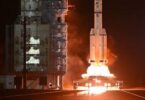Mark R. Whittington
On Jan. 19, soon after the Astrobotic Peregrine met its fiery end reentering the Earth’s atmosphere in the skies over the Pacific, the Japanese Aerospace Exploration Agency, or JAXA, SLIM lunar lander made its attempt to land on the moon.
The good news was that SLIM successfully executed the landing. Ground stations received good telemetry from the lunar lander. Two small rovers called Lunar Excursion Vehicle 1 — LEV-1 — and Lunar Excursion Vehicle 2 — LEV-2 — that had been ejected from the SLIM also sent back data.
The bad news was that the SLIM’s solar panels failed to receive energy from the sun. Since the SLIM was operating solely on battery power, flight controllers were obliged to turn the lander off after a few hours. The Japanese hope that when the sun is at an optimal angle over the lunar surface, the solar panels will start generating power again, allowing flight controllers to awaken the SLIM from its slumber.
JAXA has announced some more good news/bad news. SLIM’s precision landing technology has proven itself. That will have implications for the Artemis program by giving spacecraft the ability to land wherever is required rather than just where it is easy to land. When NASA and its international and commercial partners establish a lunar base, precision landing will be a crucial technology.
The bad news is that because one of SLIM’s engines failed during the final touchdown, the lunar lander tumbled onto its nose. JAXA released an image taken by the LEV-2 showing the lunar lander’s current position. If JAXA can get the SLIM’s solar panels working, it can also accomplish many if not all of the mission’s science goals.
In any event, Japan is now the fifth country to successfully land on the moon, after the United States, the Soviet Union, China and, most recently, India.
With its participation in the International Space Station, the Kaguya lunar orbiter and the Hayabusa asteroid mission, among other accomplishments, Japan has established itself as a major space power.
The nation is likely to expand its role as a player in space exploration. Late in 2023, the Japan Times reported that NASA and JAXA were negotiating an agreement that would include a Japanese astronaut on a future Artemis lunar surface mission. Japan was already an early signatory of the Artemis Accords, an agreement stipulating rules for operating on other celestial bodies such as the moon. Japan will also participate in the construction of the Gateway, the lunar orbital space station that NASA is planning as part of the Artemis program.
While the Japanese work to bring the SLIM lunar lander back to life, Texas-based company Intuitive Machines is gearing up for the launch of its moon lander, the Nova-C, to take place sometime in mid-February. The Intuitive Machines Nova-C is the second attempt at an American moon landing under the Commercial Lunar Payload Systems program after the failed Astrobotic Peregrine mission. To quote former NASA Administrator Jim Bridenstine, the mission is another “shot on goal” to return America to the moon.
According to NASA, the mission objective is to place Nova-C “at crater Malapert A near the south pole of the Moon.” Nova-C will carry “five NASA payloads and commercial cargo.” Other objectives include “studies of plume-surface interactions, radio astronomy and space weather interactions with the lunar surface,” and “demonstrating precision landing technologies and communication and navigation node capabilities.”
According to Rebecca Boyle, author of “OUR MOON: How Earth’s Celestial Companion Transformed the Planet, Guided Evolution, and Made Us Who We Are,” the coming arrival of commercial robots to the moon will change humankind’s relationship with our nearest neighbor forever. Pretty soon, human beings will live and work on the moon, engaged in scientific exploration and accessing its resources for the betterment of human civilization.
Boyle thinks a discussion needs to take place about what we should do on the moon before it’s too late. Considering that 45 years passed between the Apollo 17 mission and the beginning of the Artemis program, plenty of time has already passed for such a discussion. The decision-makers will be those with the willingness to invest the capital and effort to return to the moon. The Artemis Accords are the result of the effort to regulate the return to the moon,
Soon, people will walk on the lunar surface, making the moon a new frontier of human endeavor.
Courtesy: thehill







